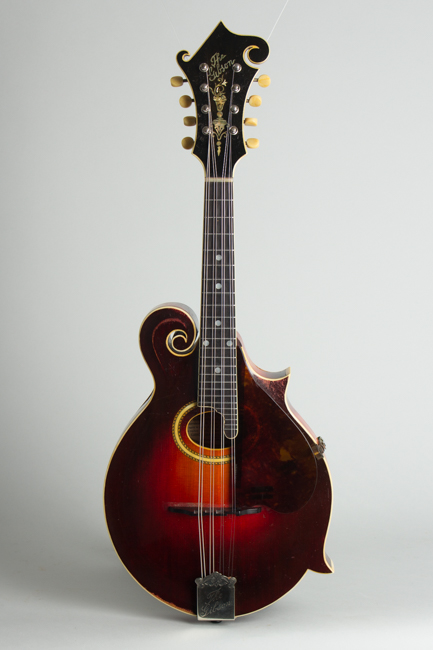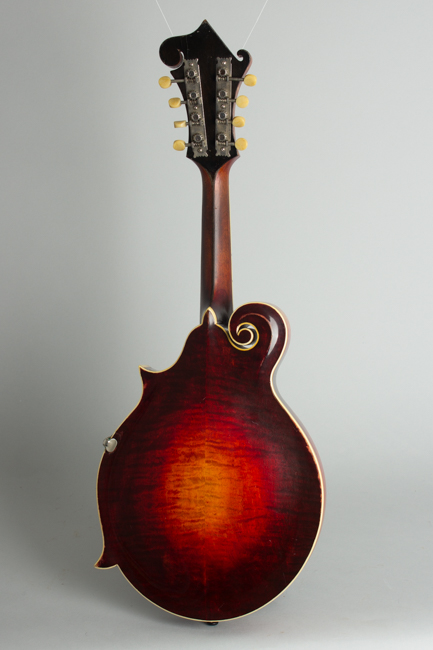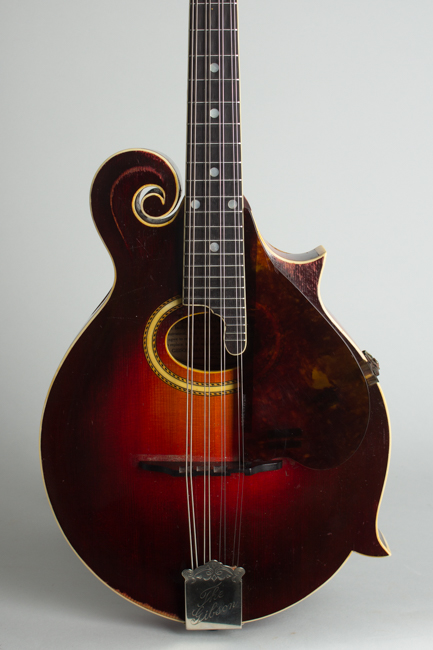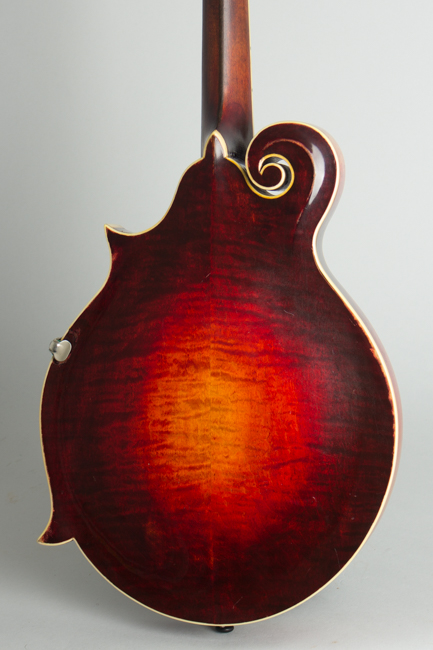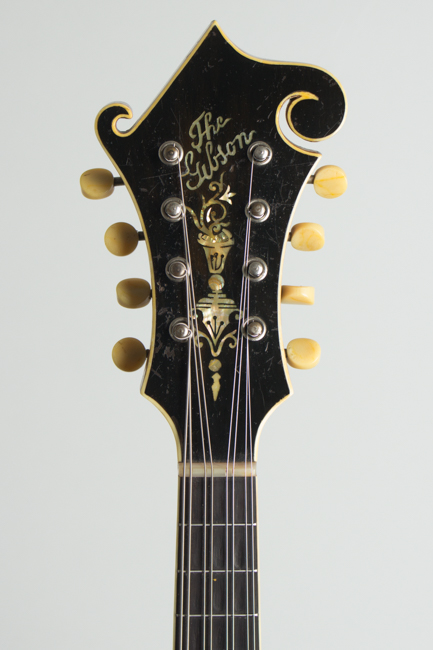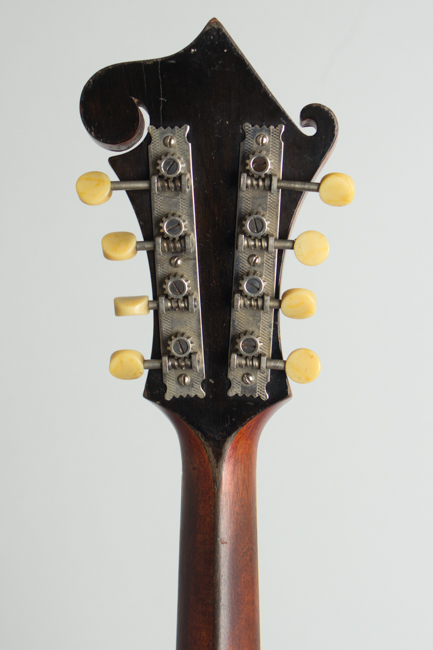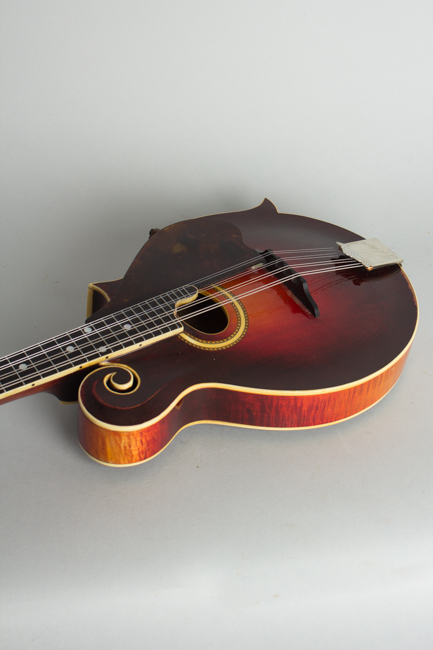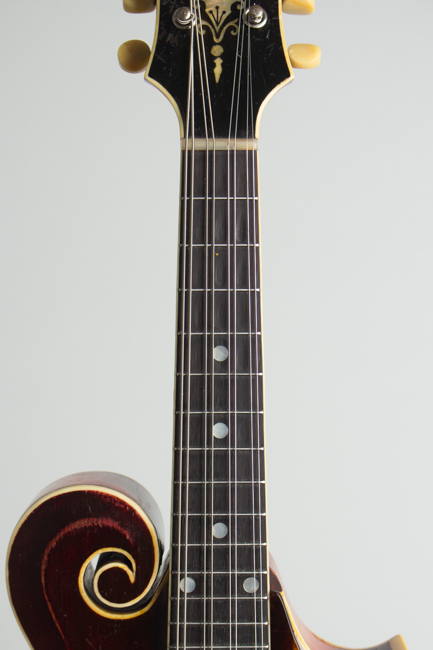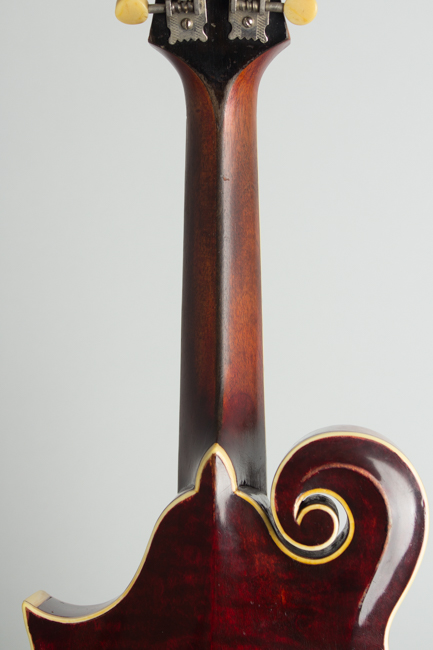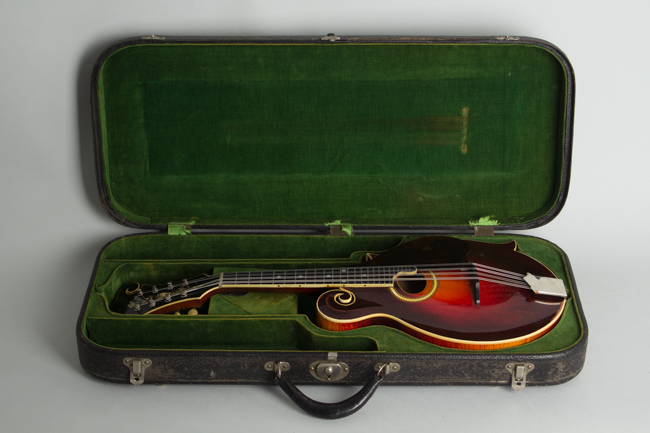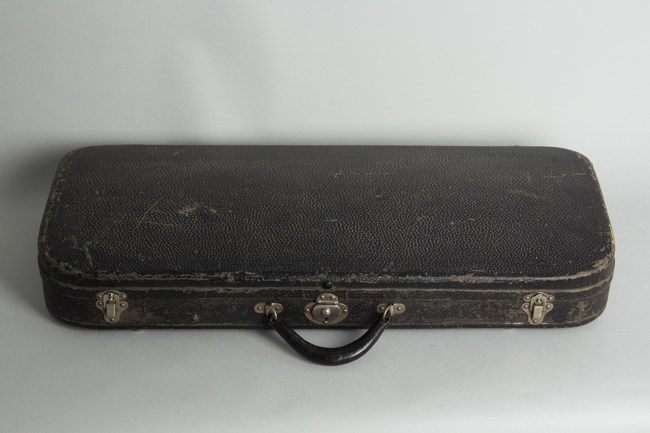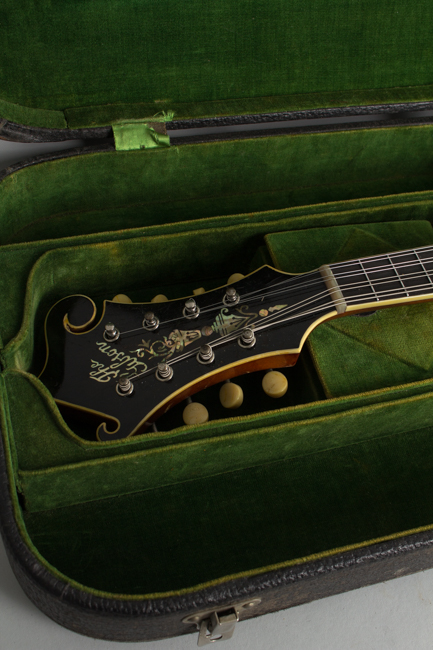Gibson Model F-4 Carved Top Mandolin (1921)
This item has been sold.
Item # 9371
Prices subject to change without notice.
Gibson Model F-4 Model Carved Top Mandolin (1921), made in Kalamazoo, Michigan, sunburst varnish finish, maple back and sides, spruce top; mahogany neck with ebony fingerboard, original black hard shell case.
As mandolins go there are not many more hallowed instruments than a Gibson Style F-4 Artist Model from the early 1920's. This example was built in 1921, just as the "Lloyd Loar" period was getting underway at Gibson. It represents a spectacular portrait of Gibson's craftsmanship at the apex of the mandolin era, just before the company's focus shifted to banjos and then to guitars.
The Mandolins from this particular time are revered for their beautiful sound, elegant Art Nouveau look and exceptional build quality, the result of nearly 20 years of Gibson perfecting their designs. The F-4 Artist's model was Gibson's highest grade mandolin until the advent of the F-hole Master Model F-5 in 1922-3, and even after that model's introduction remained at a price of $150.00 an extremely expensive and prestigious instrument. The serial number on this instrument has been penciled over and is hard to read, but the Factory order number stamped on the neck block remains clear and dates to the very tail end of 1920.
This F-4 features a two-piece back and sides of superb flamed maple; despite Gibson's catalog descriptions, only the Style 4 instruments were actually built with the specified maple body. The top, back and sides feature a beautiful deep red-orange sunburst finish and are bound in grained ivoroid. Other fittings are standard for the period including a raised tortoise celluloid pickguard with the side clamp, engraved tailpiece cover and a solid ebony bridge with a stepped compensated top.
The elaborate scrolled headstock carries the slanted "The Gibson" pearl logo over the original long "flowerpot" inlay that would be discontinued within a year or so due to the addition of a truss rod cover. The mahogany neck has an ebony center strip and is slightly slimmer than 1910's examples with a somewhat more subtle but still distinct "V" profile. The tuners are the special openback strips specific to this model, with elongated shafts on the ends and celluloid buttons. A distinctive touch from this period is a genuine pearl nut.
The venerable F-4 was somewhat overshadowed by the new heavily-promoted F-5 after 1923, but examples from the first half of the decade are the finest ever built and spectacular sounding mandolins. The tone is mellower than Gibson's subsequent F-hole instruments, but with plenty of body and "bite" when needed. This instrument would have been the top choice for any virtuoso mandolinist in 1921, and today is still an iconic creation. This one has some minor scars from nearly a century of use but like a fine old violin is still a wonderful instrument to play. A lovely touch with this F-4 is the original deluxe rectangular hard case, a work of art in itself and rarely seen as it was quite expensive at the time. The F-5 version is better known, but this slightly shorter specific F-4 variation is quite rare
Overall length is 26 1/8 in. (66.4 cm.), 10 in. (25.4 cm.) wide at lower bout, and 1 11/16 in. (4.3 cm.) in depth, measured at side of rim. Scale length is 14 in. (356 mm.). Width of nut is 1 3/16 in. (30 mm.).
This mandolin shows general wear overall but has remained original and hardly altered over the last 99 years. The finish shows numerous small dings, scratches and dents over the entire instrument but retains excellent color with virtually no fade and a lovely patina. The only major area of loss is on the back of the neck where a decent amount is rubbed away down to the wood. There are some deeper pick marks to the top off the pickguard edge by the treble end of the fingerboard, a line of finish rubbed down along the carved crest of the upper scroll and many small dings and chips in the headstock face.
The only visible cracks are a couple of small tight checks on the back of the headstock near the top scroll. These do not go all the way through and the scroll has never been detached. The body shows no cracks or even evidence of the typical seam repairs. All hardware is original and complete including the tuners, tailpiece, raised celluloid pickguard and clamp and the carved one-piece ebony bridge. There are marks to the top indicating a later adjustable bridge was likely in place for some time, but the original non-adjustable piece is now fitted.
The frets appear to be the original thin wire, crowned down slightly and showing very little wear. The fingerboard has some very minor divots in the lower positions but nothing that affects playability. The case has some external wear but is structurally excellent and perfectly functional. This is a very sweet and enjoyable mandolin to play with a sparkling sound and a most comfortable action, a wonderful survivor of the eventful century since Gibson's first glory days. Overall Excellent - Condition.
As mandolins go there are not many more hallowed instruments than a Gibson Style F-4 Artist Model from the early 1920's. This example was built in 1921, just as the "Lloyd Loar" period was getting underway at Gibson. It represents a spectacular portrait of Gibson's craftsmanship at the apex of the mandolin era, just before the company's focus shifted to banjos and then to guitars.
The Mandolins from this particular time are revered for their beautiful sound, elegant Art Nouveau look and exceptional build quality, the result of nearly 20 years of Gibson perfecting their designs. The F-4 Artist's model was Gibson's highest grade mandolin until the advent of the F-hole Master Model F-5 in 1922-3, and even after that model's introduction remained at a price of $150.00 an extremely expensive and prestigious instrument. The serial number on this instrument has been penciled over and is hard to read, but the Factory order number stamped on the neck block remains clear and dates to the very tail end of 1920.
This F-4 features a two-piece back and sides of superb flamed maple; despite Gibson's catalog descriptions, only the Style 4 instruments were actually built with the specified maple body. The top, back and sides feature a beautiful deep red-orange sunburst finish and are bound in grained ivoroid. Other fittings are standard for the period including a raised tortoise celluloid pickguard with the side clamp, engraved tailpiece cover and a solid ebony bridge with a stepped compensated top.
The elaborate scrolled headstock carries the slanted "The Gibson" pearl logo over the original long "flowerpot" inlay that would be discontinued within a year or so due to the addition of a truss rod cover. The mahogany neck has an ebony center strip and is slightly slimmer than 1910's examples with a somewhat more subtle but still distinct "V" profile. The tuners are the special openback strips specific to this model, with elongated shafts on the ends and celluloid buttons. A distinctive touch from this period is a genuine pearl nut.
The venerable F-4 was somewhat overshadowed by the new heavily-promoted F-5 after 1923, but examples from the first half of the decade are the finest ever built and spectacular sounding mandolins. The tone is mellower than Gibson's subsequent F-hole instruments, but with plenty of body and "bite" when needed. This instrument would have been the top choice for any virtuoso mandolinist in 1921, and today is still an iconic creation. This one has some minor scars from nearly a century of use but like a fine old violin is still a wonderful instrument to play. A lovely touch with this F-4 is the original deluxe rectangular hard case, a work of art in itself and rarely seen as it was quite expensive at the time. The F-5 version is better known, but this slightly shorter specific F-4 variation is quite rare
Overall length is 26 1/8 in. (66.4 cm.), 10 in. (25.4 cm.) wide at lower bout, and 1 11/16 in. (4.3 cm.) in depth, measured at side of rim. Scale length is 14 in. (356 mm.). Width of nut is 1 3/16 in. (30 mm.).
This mandolin shows general wear overall but has remained original and hardly altered over the last 99 years. The finish shows numerous small dings, scratches and dents over the entire instrument but retains excellent color with virtually no fade and a lovely patina. The only major area of loss is on the back of the neck where a decent amount is rubbed away down to the wood. There are some deeper pick marks to the top off the pickguard edge by the treble end of the fingerboard, a line of finish rubbed down along the carved crest of the upper scroll and many small dings and chips in the headstock face.
The only visible cracks are a couple of small tight checks on the back of the headstock near the top scroll. These do not go all the way through and the scroll has never been detached. The body shows no cracks or even evidence of the typical seam repairs. All hardware is original and complete including the tuners, tailpiece, raised celluloid pickguard and clamp and the carved one-piece ebony bridge. There are marks to the top indicating a later adjustable bridge was likely in place for some time, but the original non-adjustable piece is now fitted.
The frets appear to be the original thin wire, crowned down slightly and showing very little wear. The fingerboard has some very minor divots in the lower positions but nothing that affects playability. The case has some external wear but is structurally excellent and perfectly functional. This is a very sweet and enjoyable mandolin to play with a sparkling sound and a most comfortable action, a wonderful survivor of the eventful century since Gibson's first glory days. Overall Excellent - Condition.
